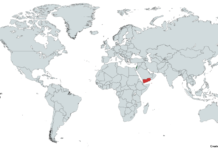3 days ago the number of global Coronavirus(COVID-19) passed the 1 million mark. Today(04/05/20) that number is greater than 1.2 million.
The virus which originated in China has since spread to over 181 countries and has killed over 66K people. The United States currently has the largest number of reported cases and with no cure in sight, there is widespread fear that the virus will continue to spread exponentially unless a cure has been found soon.
With the increase of cases in the United States, states have continued to put in place restrictions and most states have issued stay at home orders and the National Governors Association has continued to keep track of the status of each state here. 9 U.S. states have not yet issued a stay at home order and they are:
- Arkansas – Governor Asa Hutchinson said, “I understand there is a certain amount of political pressure to do what everyone else is doing. What we’re trying to accomplish here is not to be like every other state or tick off a box. What we’re trying to do is flatten that curve”.
- Iowa – Governor Kim Reynolds said, “What else are we doing by doing a shelter-in-place or stay-at-home order except for potentially disrupting the supply chain, putting additional pressure on the essential workforce, and making sure that we are considering how we bring that back up”?
- Nebraska – Governor Pete Ricketts said,”We’re a different state than states like New York that are doing that. We are much earlier in the epidemic curve than New York”.
- North Dakota – Governor Doug Burgum said, “We’re a low population state and a large low population state. I will every tool at my disposal as Governor to protect the lives and safety of North Dakotans, but I’m only going to use those tools if it makes sense and when it makes sense”.
- Oklahoma – Governor Kevin Stitt said, “In my opinion, I cannot shut things down and bunker in place”.
- South Carolina – Governor Henry McMaster said, “Every state is different. They have different economies, different resources, they have different medical facilities. We are taking a deliberate approach, to be as aggressive as we possibly can at the right time and we’re following the data and the science to do that. If you look at the orders we have issued, both those that advised as well as those that mandate, we have urged people to stay home from the very beginning.”
- South Dakota – Governor Kristi Noem said, “The calls to apply a one-size-fits-all approach to this problem in South Dakota is herd mentality, not leadership. My responsibility is to respect the rights of the people who elected me and to manage our state operations in a way that reflects the realities of what we have here on the ground here. On the foundation of my principles, commonsense conservative values, and the principles we hold dear in America, the facts, the science, and the data will guide our decision-making here in South Dakota”.
- Utah – Governor Gary Herbert previously issued a Stay Home, Stay Safe Directive and went on to say, “While we are seeing positive indications that this is slowing the spread of coronavirus in our communities, we need to do more. The clear directives issued today will help Utahns understand what activities are safe — and if we unite behind these instructions as if our lives depended upon them, we will, in fact, save many lives. The Goals of the directive are to flatten the curve, reduce the strain on hospitals and the healthcare system, and minimize the impact on medical resources for those with the highest need”.
- Wyoming – Governor Mark Gordon said, “If we’re going to issue a shelter-in-place or stay-at-home order, it will not have multiple exemptions. It will be a true stay-at-home order”.
Director of the National Institute of Allergy and Infectious Diseases Dr. Anthony Fauci said in regards to President Trump not issuing a national stay at home order yet, “I don’t understand why that’s not happening. If you look at what’s going on in this country, I just don’t understand why we’re not doing that. We really should be”.
In regards to travel within the U.S. the CDC has said, “CDC does not generally issue advisories or restrictions for travel within the United States. However, cases of coronavirus disease (COVID-19) have been reported in all states, and some areas are experiencing community spread of the disease. Crowded travel settings, like airports, may increase the chances of getting COVID-19 if there are other travelers with coronavirus infection. There are several things you should consider when deciding whether it is safe for you to travel”.
The CDC said the virus can be spread in multiple ways including:
- Between people who are in close contact with one another (within about 6 feet).
- Through respiratory droplets produced when an infected person coughs, sneezes or talks.
- These droplets can land in the mouths or noses of people who are nearby or possibly be inhaled into the lungs.
- Some recent studies have suggested that COVID-19 may be spread by people who are not showing symptoms.
- Maintaining good social distance (about 6 feet) is very important in preventing the spread of COVID-19.
- It may be possible that a person can get COVID-19 by touching a surface or object that has the virus on it and then touching their own mouth, nose, or possibly their eyes
The CDC has recommended the following for preventing the virus from spreading:
Clean your hands often
- Wash your hands often with soap and water for at least 20 seconds especially after you have been in a public place, or after blowing your nose, coughing, or sneezing.
- If soap and water are not readily available, use a hand sanitizer that contains at least 60% alcohol. Cover all surfaces of your hands and rub them together until they feel dry.
- Avoid touching your eyes, nose, and mouth with unwashed hands.
Avoid close contact
- Avoid close contact with people who are sick
- Stay home as much as possible.pdf iconexternal icon
- Put distance between yourself and other people.
- Remember that some people without symptoms may be able to spread virus.
- Keeping distance from others is especially important for people who are at higher risk of getting very sick.
Cover your mouth and nose with a cloth face cover when around others
- You could spread COVID-19 to others even if you do not feel sick.
- Everyone should wear a cloth face cover when they have to go out in public, for example to the grocery store or to pick up other necessities.
- Cloth face coverings should not be placed on young children under age 2, anyone who has trouble breathing, or is unconscious, incapacitated or otherwise unable to remove the mask without assistance.
- The cloth face cover is meant to protect other people in case you are infected.
- Do NOT use a facemask meant for a healthcare worker.
- Continue to keep about 6 feet between yourself and others. The cloth face cover is not a substitute for social distancing.
Cover coughs and sneezes
- If you are in a private setting and do not have on your cloth face covering, remember to always cover your mouth and nose with a tissue when you cough or sneeze or use the inside of your elbow.
- Throw used tissues in the trash.
- Immediately wash your hands with soap and water for at least 20 seconds. If soap and water are not readily available, clean your hands with a hand sanitizer that contains at least 60% alcohol.
Clean and disinfect
- Clean AND disinfect frequently touched surfaces daily. This includes tables, doorknobs, light switches, countertops, handles, desks, phones, keyboards, toilets, faucets, and sinks.
- If surfaces are dirty, clean them: Use detergent or soap and water prior to disinfection.
Surgeon General Jerome Adams said, “The next week is going to be our Pearl Harbor moment, it’s going to be our 9/11 moment, it’s going to be the hardest moment for many Americans in their entire lives. And we really need to understand that if we want to flatten that curve and get through to the other side, everyone needs to do their part”.
Yesterday President Trump said,” This will be probably the toughest week between this week and next week, and there will be a lot of death, unfortunately, but a lot less death than if this wasn’t done but there will be death”.









